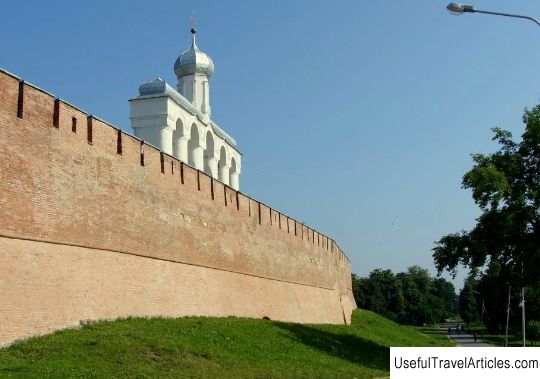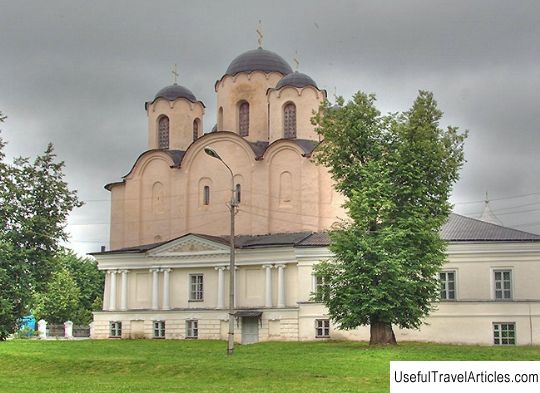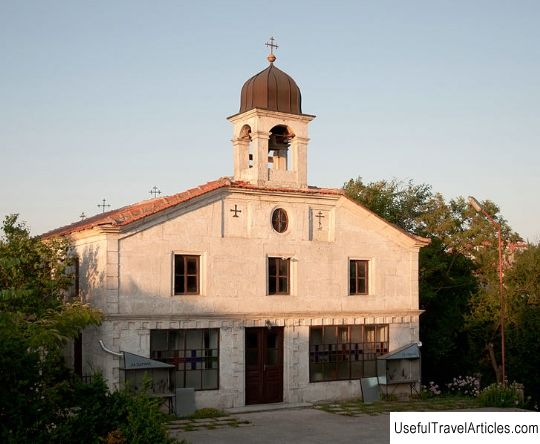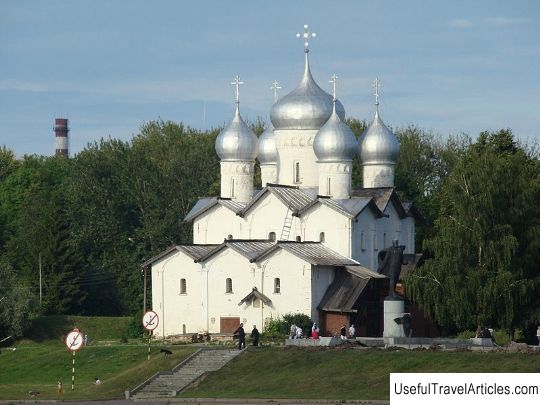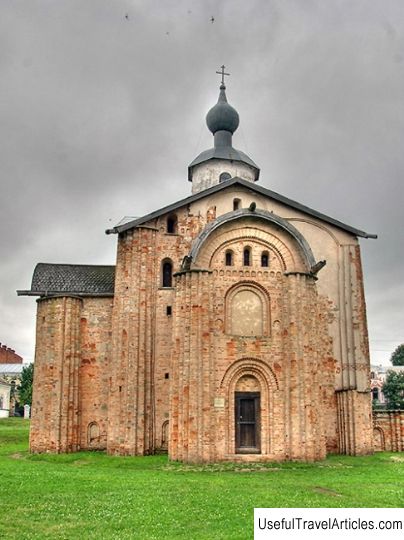Novgorod Kremlin description and photo - Russia - North-West: Veliky Novgorod
Rating: 8,0/10 (300 votes) 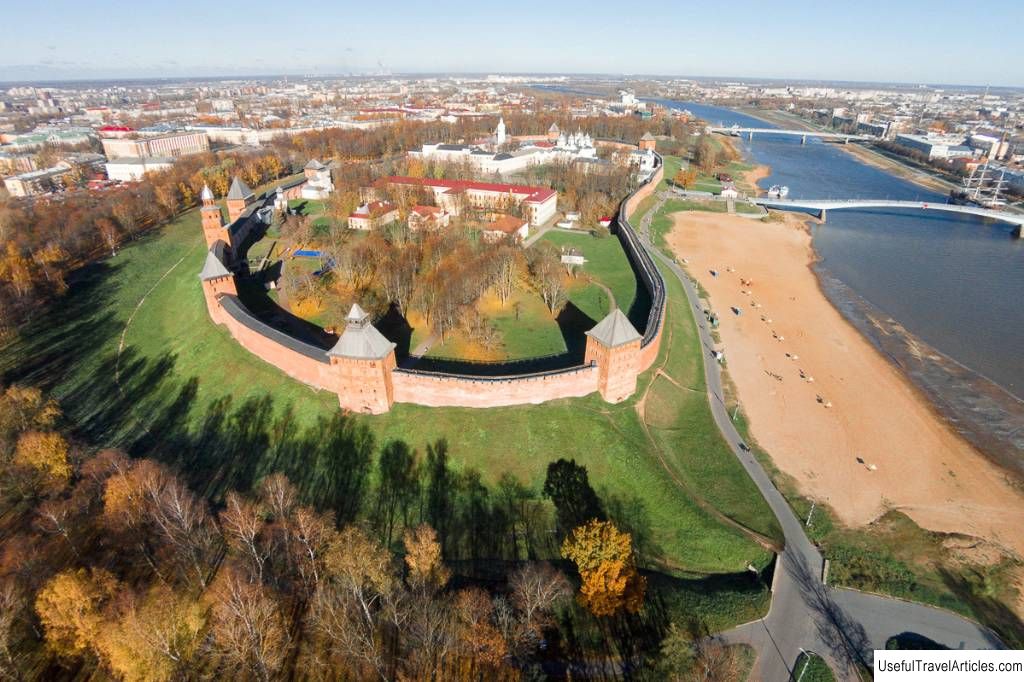
Novgorod Kremlin description and photos - Russia - Northwest: Veliky Novgorod. Detailed information about the attraction. Description, photos and a map showing the nearest significant objects. Photo and descriptionThe Novgorod Kremlin on a high hill above Volkhov is one of the largest northern kremlin in Russia. Here is the famous Novgorod Sofia, built in the XI century, museum expositions, and also has its own "Leaning Tower" and the famous monument "Millennium of Russia". Lord Novgorod the GreatThe first mention in chronicles The fortress on Volkhov dates back to 1044, but people lived here much earlier. The oak fortress with two entrances was built during the reign of the son of Yaroslav the Wise - Vladimir Yaroslavich. In those days it was small, but less than a hundred years later - in 1116 - it was expanded to the current size of the Kremlin. Stone walls appeared in the 30s of the 15th century, and in the 1490s, with the joint money of Ivan III and Novgorod Bishop Gennady, they were once again rebuilt in accordance with the new requirements. The fortifications were expanded so that full-fledged artillery could be placed on the towers, and it could drive along the walls. In 1611, the Swedes were able to take the city only because of betrayal - the walls themselves were impregnable. By the middle of the 19th century, the Kremlin was dilapidated and part of the wall collapsed. A new collapse followed at the end of the 20th century, so that two sections of the wall were recently rebuilt. During the 17th-19th centuries, the appearance of the tower finials changed, the Soviet restoration returned them to their original appearance of the 15th century. Now the Novgorod Kremlin is a perfectly preserved medieval fortress - one of the largest and most beautiful in the north of Russia. The height of the walls ranges from 8 meters to 15 meters, and the thickness in some places reaches 6.5 meters. Nine towers have survived. One of the sections, which includes six towers, can now be climbed and walked along the "combat path". St. Sophia Cathedral The main attraction of the Kremlin is this is St. Sophia Cathedral in Novgorod. It was built in 1045-1050, a little later than the famous Kiev Sophia, like that - on the model of Sophia of Constantinople. But the Novgorod Sofia, in contrast to the Kiev, better preserved its original appearance: a cross-domed five-aisled church with helmet-shaped domes. Fragments of the oldest paintings from 1109 have been preserved in the temple, but the main painting was made in the 19th century. It was closed during the Soviet years, an anti-religious museum was set up here, and during the occupation the cathedral was plundered and significantly damaged - a shell hit the central dome. After restoration, the cathedral was transferred to the museum, and since 1991 - to the Church. Now it is a functioning cathedral. It contains the main Novgorod shrine - the icon "Sign" of the 12th century. According to legend, the icon once saved the city during the battle with the Suzdal people. There is also a copy of the 16th century Tikhvin icon, considered to be miraculous. The temple served as a princely and episcopal burial vault, and now many burials are revered as shrines. The Swedish princess Ingegerd, Anna Novgorodskaya, the wife of Yaroslav the Wise, and her son Vladimir Yaroslavich, under whom the cathedral was built, were canonized. Here lie two holy Novgorod bishops - St. Nikita and St. Ilya. Another unique attraction of the temple is the Magdeburg Gate. These are the bronze doors of the western portal, made by Western European craftsmen. There are several versions about how exactly they appeared here - whether they were a military trophy, or a gift. According to one version, they were brought from Byzantium by Prince Vladimir, so their second name is "Korsunskie". An interesting 15th-century cathedral belfry has survived, most of all similar to a part of the wall with five bell spans. Now it is used for its intended purpose and, in addition, next to it is an exhibition of ancient Novgorod bells, sent "retired". Kremlin temples In addition to the current cathedral, there are several other interesting churches on the territory of the Kremlin. This is the small church of Andrew Stratilates, built in the 15th century and rebuilt in the 17th and 19th centuries. In fact, this building is the remnant of the large Borisoglebsk Cathedral, which was dismantled in the 17th century. Only the side chapel remained of it. The church has preserved murals of the XVI-XVII centuries, now it is part of the museum, admission is paid. Gate Church of St. St. Sergius of Radonezh, built in the middle of the 15th century, is quite common, but you cannot miss the high tower adjacent to it - the clock chime. It was built at the end of the 17th century. This is the Novgorod "leaning" tower - it has a rather noticeable heel, but so far, according to scientists, immediate strengthening is not required. The lecture hall of the Novgorod Museum is located in the building of the former Church of the Entry of the Lord into Jerusalem. It was a warm side-chapel of St. Sophia Cathedral, built in the 17th century. Now the building has retained only its original volume and wall decor, the dome was dismantled during the Soviet era. The Faceted Chamber and the Museum Complex Besides the ancient temples, the Kremlin also has one of the oldest monuments of civil architecture. In the middle of the 15th century, a new residence for the Novgorod bishops was built here and at the same time an administrative center - the Vladychny Dvor, in the construction of which German craftsmen took part. The Faceted (Vladychna) Chamber is the only Gothic example of civil architecture in Russia. It was here that the meetings of the highest Novgorod authorities - the Council of Masters - took place. It was there that the annexation of Novgorod to the Moscow principality was announced. The building was rebuilt in the 19th century and restored already at the beginning of the 21st century, it was restored to its original appearance if possible. Now it houses an exhibition of jewelry art of the 16th-17th centuries. - "Golden Pantry". Another exhibition is the "Chamber of Archbishop Euthymius", which tells about the Novgorod bishops and their lives. The main exposition of the museum is located in a two-story building of public places - the administrative center of the late 18th century, designed by the provincial architect V. Polivanov. The museum itself was created in 1865 to celebrate the 1000th anniversary of Russia. There is a plaque on it in memory of the founder - priest Nikolai Bogoslovsky. The most interesting thing in the museum is a collection of the famous Novgorod birch bark letters. The unique climate and soil composition preserved birch bark for us. We know many interesting details of the private life of medieval Novgorod. Names, biographies, prices of goods, love and detective stories - all this can appear before us from these letters. The museum has the richest archaeological collection: the soil of Novgorod made it possible to preserve fabrics, leather, wood practically intact. In addition, there is a collection of arts and crafts from Novgorod churches, the museum also has one of the most extensive collection of icon painting in Russia from the 11th century. A separate exposition is dedicated to the Great Patriotic War, its pearl is the Kukryniksy painting "The Flight of the Nazis from Novgorod". Monument to the 1000th Anniversary of Russia Temporary exhibitions are held by the museum in the assignment of the former barracks of the 19th century, built together with the section of the wall that collapsed then. In addition, there is a children's museum center here: an interactive exhibition dedicated to medieval Novgorod - "City of the boy Onfim", a literary and art salon, and more. The Novgorod Kremlin has a huge monument to the Millennium of Russia. In 1862, the Russian Empire magnificently celebrated the millennium of the vocation of the Varangians - this also coincided with the beginning of reforms, the abolition of serfdom and a general "thaw". Several sculptors and architects worked on it. The height of the grandiose monument is 15.7 meters. It is a symbol of royal power - a state crowned with an angel with a cross and Russia kneeling before it. The orb sphere is surrounded by sculptural groups that tell about the history of the country. It tells about all the key milestones in Russian history, from the vocation of the Varangians to Peter I. The relief of the lower part of the monument depicts 109 historical figures from ancient times. There are also characters that are almost modern to the monument, for example, the heroes of the defense of Sevastopol P. Nakhimov and V. Kornilov, poets A. Pushkin and V. Zhukovsky, composers M. Glinka and D. Bortyansky ... Those who could be depicted on this monument were chosen very carefully - even the monarchs are not all depicted here. During the war, the Germans dismantled the sculptures in order to take them out. Many parts were lost and damaged during the dismantling process. But immediately after the wars, the monument was restored. There is also another memorial in the Kremlin on the site of a mass grave - an eternal flame dedicated to the memory of those who died in the Great Patriotic War. Interesting facts        We also recommend reading The Cathedral of Saint Mary Blessed Virgin description and photos - Ireland: Limerick Topic: Novgorod Kremlin description and photo - Russia - North-West: Veliky Novgorod. |

